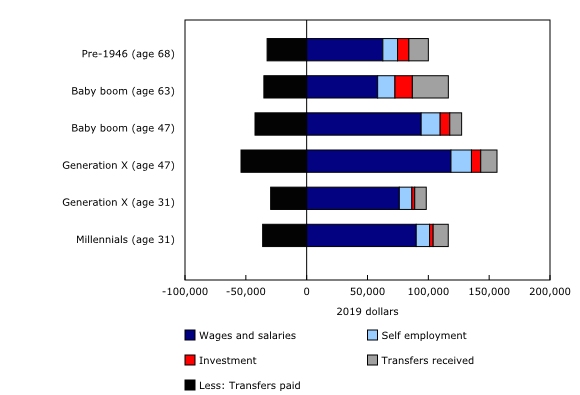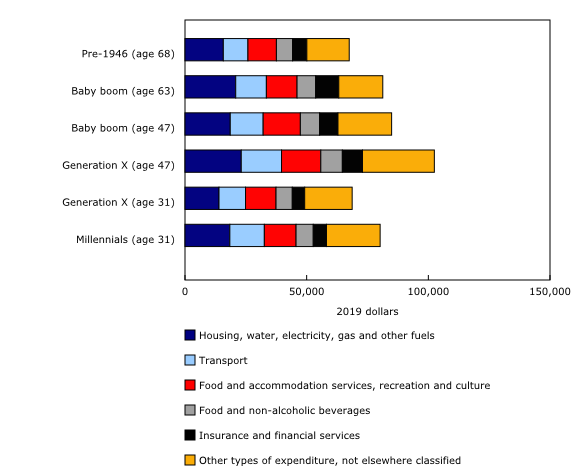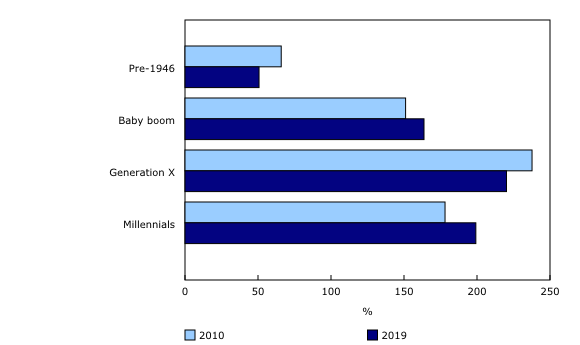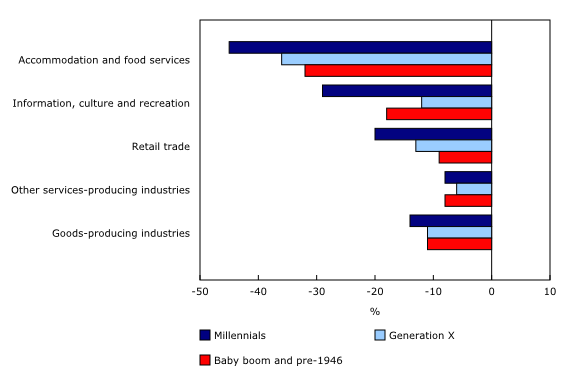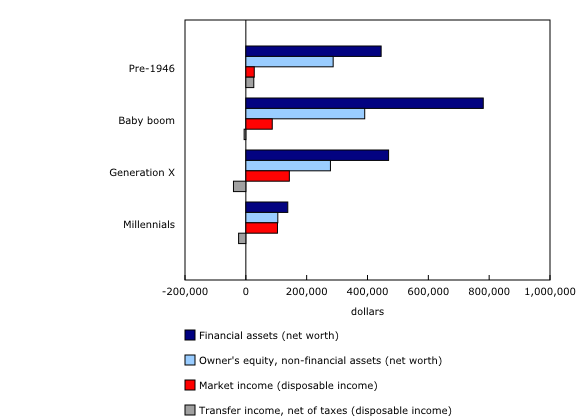Inter-generational comparisons of household economic well-being, 1999 to 2019
Archived Content
Information identified as archived is provided for reference, research or recordkeeping purposes. It is not subject to the Government of Canada Web Standards and has not been altered or updated since it was archived. Please "contact us" to request a format other than those available.
Released: 2020-12-10
Economic well-being of millennials at risk due to the COVID-19 pandemic
Households in Canada are experiencing a profound disruption in their lives as a result of the COVID-19 pandemic, with many facing chronic job loss and financial uncertainty. In the midst of the pandemic, the economic well-being of younger households, especially those with a major income earner in the millennial generation, is at greater risk since they 1) depend more on wages and salaries as a source of income; 2) face higher entry costs related to housing; 3) have higher and increasing debt relative to income; 4) work in industries deeply affected by the COVID-19 pandemic; and 5) have less equity in financial and real estate assets from which to draw upon when needed.
The study entitled "Inter-generational comparisons of household economic well-being" released today is based on the latest estimates from the Distributions of Household Economic Accounts (DHEA), up to reference year 2019. Based on historic trends, the study describes the likely impacts of the COVID-19 pandemic on inter-generational household economic well-being. The findings from this study serve as a pre-cursor to new DHEA data, currently being developed in the National Economic Accounts Division of Statistics Canada, which will provide experimental estimates of the impact of the COVID-19 pandemic on households' income, consumption, expenditure and wealth. Data up to the third quarter of 2020 are tentatively scheduled to be released in winter 2021.
In the DHEA, generations are grouped into four categories, based on the birth year of the major income earner in the household: the pre-1946 generation; the baby-boom generation, including those born in the post-war period from 1946 to 1964; Generation X, including those born from 1965 to 1980; and millennials, including the children of boomers born after 1980. In the DHEA, millennial households include Generation Z―those with a major income earner born after 1996―as their sample size is relatively small.
Younger generations derive more of their income from wages and salaries than older generations
Data from the DHEA indicate that, in inflation-adjusted terms, for millennial households that reached the age of 31 in 2019, their average disposable income was $80,200. This is higher than for those Generation X households who, upon reaching the same age in 2002, had $68,700. Most of the difference in disposable income for millennial households is due to higher wages and salaries. The larger reliance on wages and salaries puts millennial households at greater economic risk, since recent assessments of the Canadian economy have noted that, while financial markets and real estate values have remained relatively stable since the beginning of 2020, the COVID-19 pandemic is having a more noticeable impact on employment.
Higher consumption expenditures for younger generations due mainly to housing and utility costs
While millennials earned more than Generation X when they both reached the age of 31, they also spent more in inflation-adjusted terms, at $80,189 versus $68,688 respectively. Millennials faced higher costs than Generation X around this age, when many of these households began families and started buying their own homes. As costs related to housing are non-discretionary, millennial households may not have as much flexibility to adjust their spending when their income declines.
Generation X have highest debt-to-income ratio, but ratio for millennials increases
While the debt-to-income ratio was highest in 2019 for Generation X households, at 220%, that ratio has decreased by 18 percentage points since 2010 as their disposable income grew by more than their mortgage debt. In contrast, millennials have increased their ratio from 178% in 2010 to 199% in 2019. While millennials' growing real estate values have more than compensated for their increased debt, disposable income has not kept pace, growing at an average of 5% per year compared with 6% for debt. Along with rising debt-to-income ratios, it may become increasingly difficult for millennials to cover their debt obligations if they lose their jobs or have to reduce their work hours as a result of the pandemic.
Millennials' economic well-being more at risk as they work in industries deeply affected by the COVID-19 pandemic
Employment for millennials fell more sharply than for older generations in services-producing industries, where younger generations tend to comprise a higher share of the total workforce. As of the second quarter of 2020, employment for millennial workers fell by about 45% from the prior year in accommodation and food services, by 29% in information, culture and recreation, and by 20% in retail trade.
…and younger generations have less equity from which to draw upon when needed
Going forward, millennials may continue to face challenges in servicing their consumption and debt obligations, as they have not accumulated as much financial assets—through investments in stocks and bonds, etc.—and equity in real estate from which to draw upon relative to older generations. The net worth of millennial households is one-third the value held by Generation X, one-fifth of boomers, and one-third of the pre-1946 generation.
As the impacts of the COVID-19 pandemic continue to work their way through the economy, the well-being of millennial households may be more at risk relative to older generations, despite the introduction of unprecedented income support programs. Due to uncertainty in their disposable income, some millennials may choose to postpone major life events such as buying a house, starting a family and investing in their children's education.
Note to readers
Estimates of inter-generational household economic well-being from the Distributions of Household Economic Accounts (DHEA) compares households' economic well-being from a macro-economic accounts perspective, as measured by net saving and net worth for each generation when the major income earner for a household in one generation reached the same point in the life cycle as the major income earner for a household in another generation.
Grouping households by generation can provide insights into how decisions to spend, save and generate wealth may be affected by the varying socio-economic conditions that exist at different points in time. In the DHEA, generations are grouped into four categories, based on the birth year of the major income earner in the household: the pre-1946 generation, whose early lives were marked by world war and economic crisis; the baby-boom generation, including those born in the post-war period from 1946 to 1964, who grew up during a time of rising birth rates, greater economic stability and social reform; Generation X, including those born from 1965 to 1980, whose early adult life experiences were characterized by comparatively lower birth rates and less robust economic growth; and millennials, including the children of boomers born after 1980, who were the first generation to become adults in the new millennium. In the DHEA, millennial households include Generation Z, those with a major income earner born after 1996, as their sample size is relatively small.
Households have different sources of income and varying consumption needs and preferences as they progress through the life cycle, including: early adulthood, when a major income earner completes his/her education and training and embarks on a career; middle age, when a career is established and some may choose to start a family and support the development of their children; and senior age, when a major income earner may transition to retirement and draw from a pension or receive social benefits.
A household may derive its disposable income from a number of sources, including from labour compensation such as wages and salaries, property income from receipts of interest and dividends, transfers from employer-sponsored pension plans, and from social benefits provided by governments and non-profit institutions serving households. In the DHEA, disposable income is presented net of all associated payments for taxes, interest paid and social contributions. Households may also receive self-employment income (i.e., mixed income) from the operation of an unincorporated business, from direct rental income, and also from imputed rental income for owner-occupiers of dwellings.
Household consumption expenditure consists mainly of cash outlays for consumer goods and services, but it also includes imputed expenditures related to owner-occupied rent.
Products
The document, "Inter-generational comparisons of household economic well-being," which is part of Latest Developments in the Canadian Economic Accounts (13-605-X), is now available.
The Economic accounts statistics portal, accessible from the Subjects module of our website, features an up-to-date portrait of national and provincial economies and their structure.
The User Guide: Canadian System of Macroeconomic Accounts (13-606-G) is available.
The Methodological Guide: Canadian System of Macroeconomic Accounts (13-607-X) is available.
Contact information
For more information, or to enquire about the concepts, methods or data quality of this release, contact us (toll-free 1-800-263-1136; 514-283-8300; STATCAN.infostats-infostats.STATCAN@canada.ca) or Media Relations (613-951-4636; STATCAN.mediahotline-ligneinfomedias.STATCAN@canada.ca).
- Date modified:


